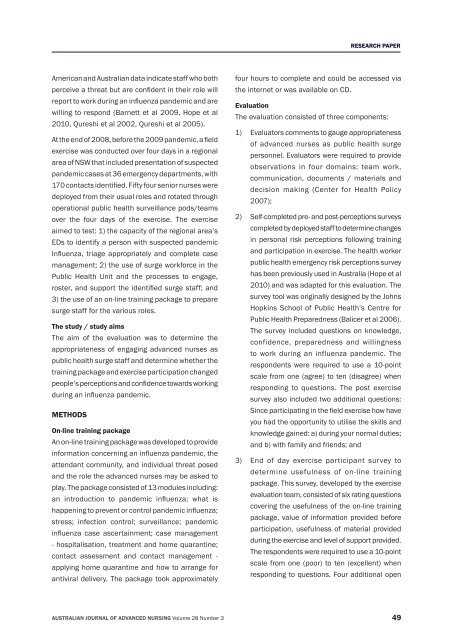australian journal of advanced nursing
australian journal of advanced nursing
australian journal of advanced nursing
Create successful ePaper yourself
Turn your PDF publications into a flip-book with our unique Google optimized e-Paper software.
American and Australian data indicate staff who both<br />
perceive a threat but are confident in their role will<br />
report to work during an influenza pandemic and are<br />
willing to respond (Barnett et al 2009, Hope et al<br />
2010, Qureshi et al 2002, Qureshi et al 2005).<br />
At the end <strong>of</strong> 2008, before the 2009 pandemic, a field<br />
exercise was conducted over four days in a regional<br />
area <strong>of</strong> NSW that included presentation <strong>of</strong> suspected<br />
pandemic cases at 36 emergency departments, with<br />
170 contacts identified. Fifty four senior nurses were<br />
deployed from their usual roles and rotated through<br />
operational public health surveillance pods/teams<br />
over the four days <strong>of</strong> the exercise. The exercise<br />
aimed to test: 1) the capacity <strong>of</strong> the regional area’s<br />
EDs to identify a person with suspected pandemic<br />
Influenza, triage appropriately and complete case<br />
management; 2) the use <strong>of</strong> surge workforce in the<br />
Public Health Unit and the processes to engage,<br />
roster, and support the identified surge staff; and<br />
3) the use <strong>of</strong> an on‑line training package to prepare<br />
surge staff for the various roles.<br />
The study / study aims<br />
The aim <strong>of</strong> the evaluation was to determine the<br />
appropriateness <strong>of</strong> engaging <strong>advanced</strong> nurses as<br />
public health surge staff and determine whether the<br />
training package and exercise participation changed<br />
people’sperceptionsandconfidencetowardsworking<br />
during an influenza pandemic.<br />
METHODS<br />
On‑line training package<br />
An on‑line training package was developed to provide<br />
information concerning an influenza pandemic, the<br />
attendant community, and individual threat posed<br />
and the role the <strong>advanced</strong> nurses may be asked to<br />
play. The package consisted <strong>of</strong> 13 modules including:<br />
an introduction to pandemic influenza; what is<br />
happening to prevent or control pandemic influenza;<br />
stress; infection control; surveillance; pandemic<br />
influenza case ascertainment; case management<br />
‑ hospitalisation, treatment and home quarantine;<br />
contact assessment and contact management ‑<br />
applying home quarantine and how to arrange for<br />
antiviral delivery. The package took approximately<br />
RESEARCH PAPER<br />
four hours to complete and could be accessed via<br />
the internet or was available on CD.<br />
Evaluation<br />
The evaluation consisted <strong>of</strong> three components:<br />
1) Evaluators comments to gauge appropriateness<br />
<strong>of</strong> <strong>advanced</strong> nurses as public health surge<br />
personnel. Evaluators were required to provide<br />
observations in four domains: team work,<br />
communication, documents / materials and<br />
decision making (Center for Health Policy<br />
2007);<br />
2) Self‑completed pre‑ and post‑perceptions surveys<br />
completed by deployed staff to determine changes<br />
in personal risk perceptions following training<br />
and participation in exercise. The health worker<br />
public health emergency risk perceptions survey<br />
has been previously used in Australia (Hope et al<br />
2010) and was adapted for this evaluation. The<br />
survey tool was originally designed by the Johns<br />
Hopkins School <strong>of</strong> Public Health’s Centre for<br />
Public Health Preparedness (Balicer et al 2006).<br />
The survey included questions on knowledge,<br />
confidence, preparedness and willingness<br />
to work during an influenza pandemic. The<br />
respondents were required to use a 10‑point<br />
scale from one (agree) to ten (disagree) when<br />
responding to questions. The post exercise<br />
survey also included two additional questions:<br />
Since participating in the field exercise how have<br />
you had the opportunity to utilise the skills and<br />
knowledge gained: a) during your normal duties;<br />
and b) with family and friends; and<br />
3) End <strong>of</strong> day exercise participant survey to<br />
determine usefulness <strong>of</strong> on‑line training<br />
package. This survey, developed by the exercise<br />
evaluation team, consisted <strong>of</strong> six rating questions<br />
covering the usefulness <strong>of</strong> the on‑line training<br />
package, value <strong>of</strong> information provided before<br />
participation, usefulness <strong>of</strong> material provided<br />
during the exercise and level <strong>of</strong> support provided.<br />
The respondents were required to use a 10‑point<br />
scale from one (poor) to ten (excellent) when<br />
responding to questions. Four additional open<br />
AUSTRALIAN JOURNAL OF ADVANCED NURSING Volume 28 Number 3 49

















